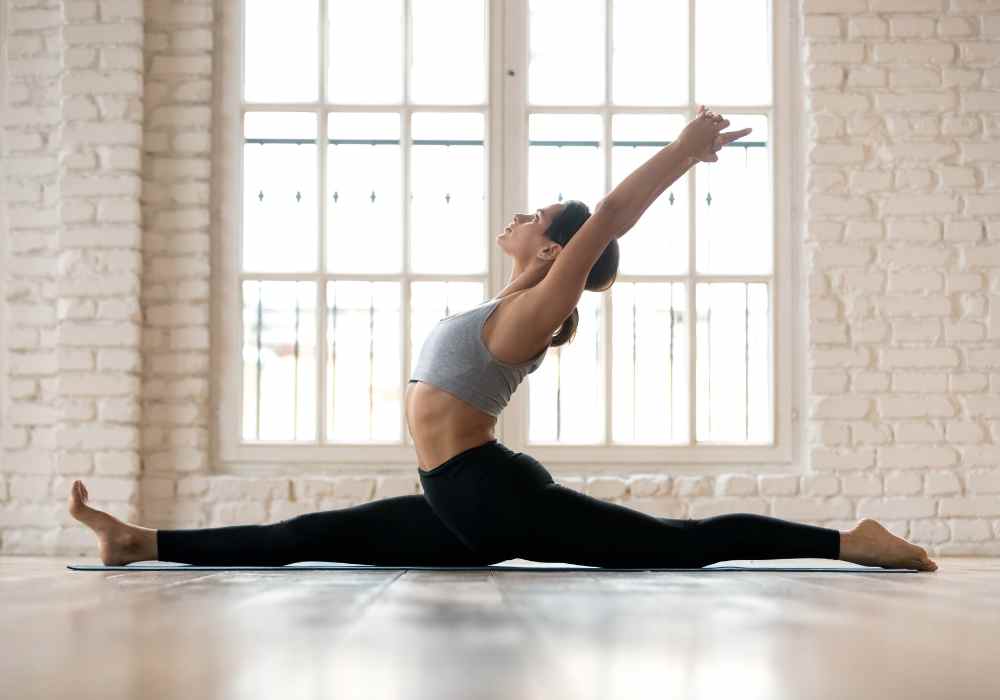Exploring Hanumanasana (Monkey Pose)
Hanumanasana, sometimes referred to as Splits Pose Yoga or Monkey Pose, is a potent yoga pose that symbolizes strength, flexibility, and dedication. This stance, named for the Hindu deity Hanuman, who is renowned for leaping across the ocean to reach Lanka, represents bravery, tenacity, and the capacity to conquer challenges. Hanumanasana is a challenging pose at first, but it can be mastered with patience and constant practice, leading to many mental and physical advantages. Let’s examine the procedures, advantages, and safety measures related to this posture.
Steps to Practice Hanumanasana (Monlkey Pose):
- Warm-up: Start by carefully warming up your entire body, paying special attention to your hamstrings, quadriceps, hip flexors, and groin muscles. Good warm-ups include Sun Salutations (Surya Namaskar) and hip-opening positions like Bound Angle Pose (Baddha Konasana) and Low Lunge (Anjaneyasana).
- From Downward Facing Dog: Starting in Downward Facing Dog (Adho Mukha Svanasana), begin in this pose. Draw in a deep breath.
- Step Forward: Take a deep breath out, and place your right foot between your hands to assume a Low Lunge posture.
- Slide Into Split: While keeping your right leg straight, slowly start to move your right foot forward. Slide your left leg back along the ground simultaneously. When necessary, use your hands and fingertips as support.
- Lower Hips: While maintaining a straight upper torso, lower your hips towards the floor. To keep your pelvis stable, contract your core muscles.
- Alignment: Make sure your front leg and hips are in line with each other and the ankle. Maintain your rear leg extended behind you, knee and toes pointed skyward.
- Maintain Length: Keep your chest raised and elongate your spine. Refrain from hunching over.
- Hold and Breathe: Maintain a balance between effort and ease while holding the pose for a few breaths. Work your way up to a deeper stretch gradually; don’t strain or force yourself.
- Change Sides: Return to Downward Facing Dog after gently sliding your front foot back to release. Stepping the left foot forward, repeat the motion on the other side.
- Cool Down: After completing both sides, give Child’s Pose (Balasana) or Corpse Pose (Savasana) a moment to rest so that your body may unwind and assimilate the benefits of the pose.
Benefits of Hanumanasana (Monkey Pose):
- Enhances Flexibility: The main benefits of Hanumanasana for improving flexibility and range of motion in the lower body include the hamstrings, quadriceps, hip flexors, and groin muscles.
- Strengthens Muscles: This position helps to promote stability and balance by strengthening the muscles in the lower back, legs, and core.
- Stimulates Abdominal Organs: Monkey Pose Yoga compression of the abdomen stimulates the digestive system, which improves gut health and aids in digestion.
- Reduces Sciatic Pain: By stretching the sciatic nerve and relieving tension in the hips and lower back, regular practice of monkey pose can help reduce sciatic pain.
- Promotes Emotional Release: It is thought that Hanumanasana’s deep hip opening may help to release tension and pent-up emotions, leading to a feeling of emotional freedom and well-being.
Precautions and Contraindications of Hanumanasana (Monkey Pose):
Despite the many advantages of Hanumanasana, you should always exercise caution when performing it, particularly if you have any injuries or pre-existing ailments. The following are some safety measures to remember:
- Get warmed up Sufficiently: To avoid injury and guarantee optimal flexibility, always warm up your body completely before attempting Hanumanasana.
- Take It Slow: Refrain from pushing yourself to achieve the pose’s maximum expression. Pay attention to your body’s instructions and move slowly. Pain is abnormal; discomfort is normal.
- Adjust as Needed: Use props like yoga blocks or blankets to support your hands or hips if you’re unable to fully extend into the splits. As a warm-up pose, you can also perform Half Splits (Ardha Hanumanasana).
- Avoid If Pregnant: To avoid straining the pelvic area during pregnancy, pregnant women should avoid deep hip-opening postures like Hanumanasana, especially in the later stages of the pregnancy.
- Conditions & Injuries: Perform this posture carefully or not at all if you have a herniated disc, hip or knee issues, or hamstring strains. If you are concerned, speak with a medical professional or a qualified yoga instructor before attempting.
Hanumanasana is a journey of self-discovery, resilience, and surrender, not just a physical posture. This position has the ability to transform you both on and off the mat; all it takes is regular practice and focused awareness. Let Hanuman’s energy lead you to inner freedom, flexibility, and power as you approach it with reverence, patience, and an open heart.
Learn to know more about yoga asana so you can visit the best yoga school in rishikesh and join 200 hour yoga teacher training in rishikesh and 300 hour yoga teacher training in rishikesh and aerial yoga teacher training in rishikesh



